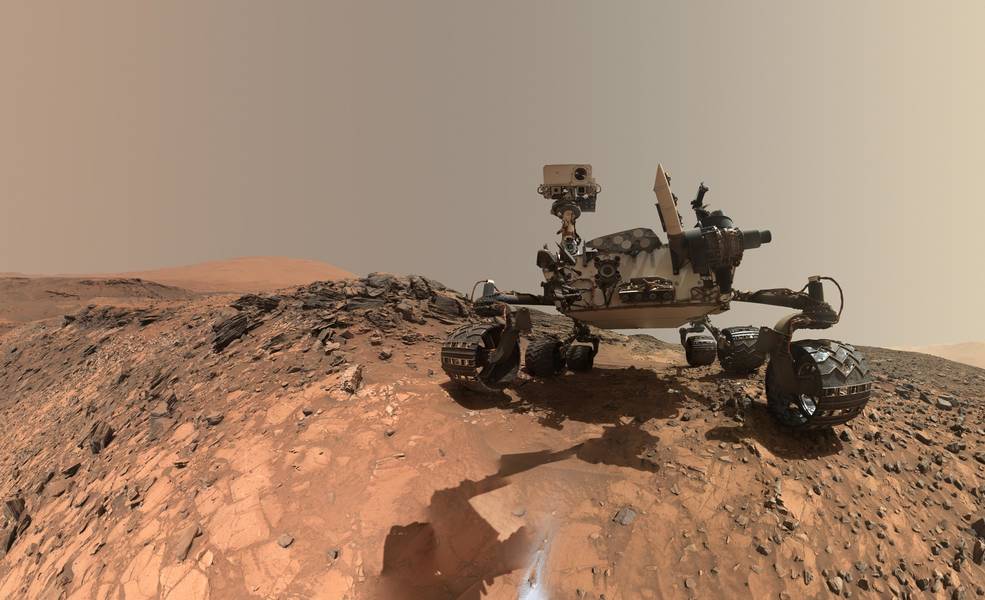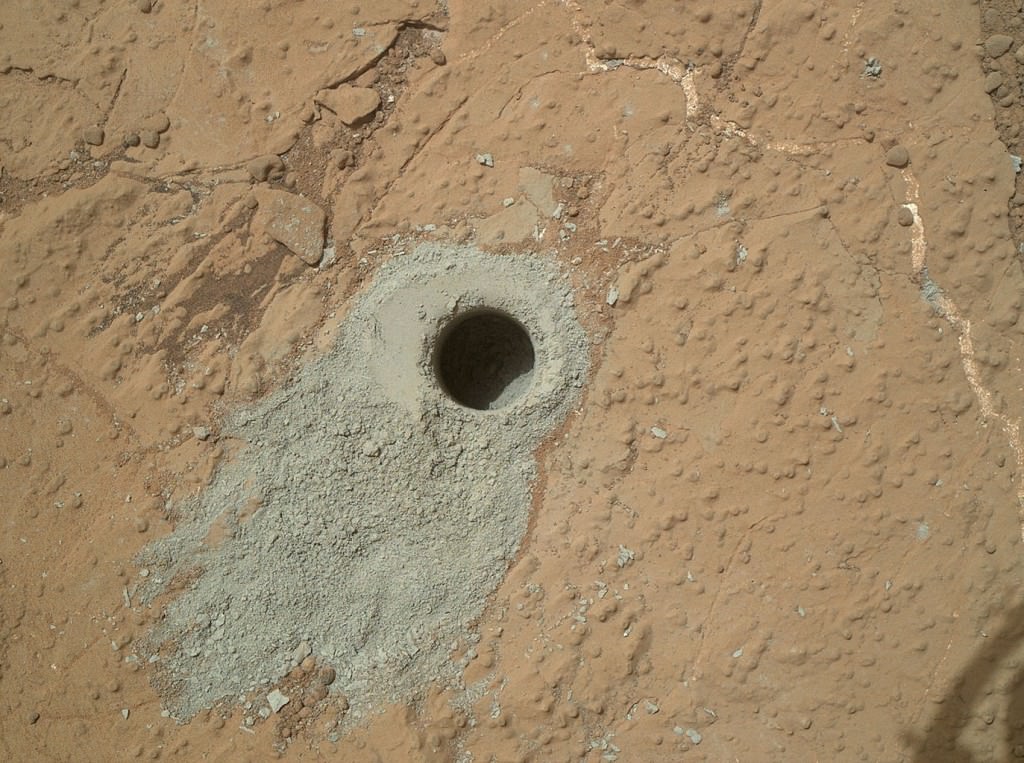
Since the 1970s, the ongoing exploration of Mars has revealed that the planet has had a most interesting history. While conditions there are not hospitable to life today, scientists know Mars was once a much warmer, wetter place, with flowing water on its surface. According to new research led by the University of Arizona (UoA), Mars may have been a “pale blue dot” covered with oceans while Earth was still a ball of slowly-cooling molten rock. This discovery could allow for new research into a previously-overlooked period in Mars’ geological history and the formation and evolution of the Solar System.
The team was led by Kaveh Pahlevan, a research scientist at ASU’s School of Earth & Space Exploration (SESE) and the Carl Sagan Center SETI Institute. He was joined by Laura Schaefer, an assistant professor of Geological Sciences at Standford University; Linda T. Elkins-Tanton, a professor of planetary science and the Director of ASU’s SESE; SESE professor of astrophysics Steven J.Desch, and ASU-SESE; and Peter R. Buseck, a Regents’ Professor at SESE and the ASU School of Molecular Sciences (SMS).

The paper that describes their findings, titled “A primordial atmospheric origin of hydrospheric deuterium enrichment on Mars,” appeared in the October 1st issue of the Earth and Planetary Science Letters. Based on multiple lines of evidence obtained by robotic orbiters, landers, and rovers, scientists have established that roughly 4.2 to 3.7 billion years ago, Mars began transitioning from a warmer, wetter planet to the extremely cold and dry environment we see there today. However, there remain unanswered questions about how long liquid water flowed on Mars’s surface and whether it was intermittent or consistent.
Mars Primordial Atmosphere
To answer this question, astronomers have been trying to reconstruct what Mars’ atmosphere was like billions of years ago. A popular method used by Martian missions involves collecting samples and analyzing them for their deuterium-to-hydrogen ratios (D/H or 2H/1H), or the number of deuterium atoms in a sample divided by the number of normal hydrogen atoms. This method allows scientists to gauge the prevalence of molecular hydrogen (H) in Mars’ atmosphere over time, which is a powerful greenhouse gas. As Prof. Desch said in an ASU News release:
“It’s a paradox that so many observations suggest liquid water on early Mars, even though water freezes on present-day Mars, and the ancient sun was 30% dimmer than today. Traditionally considered greenhouse gases like CO2 would freeze on an early Mars. Hydrogen in the atmosphere is an unexpected way to stabilize liquid water.”
For the sake of their study, the team developed the first model of primordial atmospheric evolution on Mars that included high-temperature processes associated with different geological periods. This included the formation of Mars, the time when its surface was covered in a magma ocean, and the formation of the first oceans and atmosphere. These models showed that the main gases emerging from the molten rock were a mix of molecular hydrogen and water vapor and that Mars’ earliest atmosphere was much denser than it is today.

Their model also showed that water vapor in the Martian atmosphere behaved similarly to how it behaves in Earth’s atmosphere today. Essentially, it would condense in the lower atmosphere as clouds, while very little was retained in the upper atmosphere. Meanwhile, the molecular hydrogen (the main component in the atmosphere) did not condense and was slowly lost to space. They further calculated that the molecular hydrogen content of the atmosphere would have a significant greenhouse effect, to the point that Mars could have had warm-water (or even hot) oceans.
These oceans were stable and would have remained on the Martian surface for many eons before the atmospheric hydrogen was gradually lost to space. As Dr. Pahlevan explained:
“This key insight – that water vapor condenses and is retained on early Mars whereas molecular hydrogen does not condense and can escape – allows the model to be linked directly to measurements made by spacecraft, specifically, the Mars Science Laboratory rover Curiosity. This is the first model that naturally reproduces these observations, giving us some confidence that the evolutionary scenario we have described corresponds to the earliest events on Mars.”
Implications for Life
The results are consistent with what clay samples obtained by NASA’s Curiosity rover revealed about the Hesperian Era (ca. 3.7 – 2.9 billion years ago) and reinforced what previous Martian meteorites studies showed. Martian meteors are composed largely of igneous rock (i.e., volcanic) that formed in Mars’ interior and were ejected by magma rising to the surface. These meteors contain water dissolved in the interior and were found to have D/H ratios similar to Earth’s oceans. This shows that Earth and Mars got their water from the same source during the early Solar System.

In addition, the research conducted by Dr. Pahlevan and his colleagues showed that if the primordial Martian atmosphere were dense and hydrogen-rich, the surface waters would have been naturally deuterium-enriched by a factor of two to three compared to the interior. This is what the Hesperian-era clay samples obtained by Curiosity showed, which was a D/H value about three times that of Earth’s oceans. The only explanation is that molecular hydrogen was lost to space between the period when Mars was still in formation (ca. 4.5 billion years ago) and the Hesperian Era.
As the heavier element, deuterium was lost at a slower rate, leading to the observed levels of enrichment in the surface water. These findings could also have implications in the ongoing search for evidence of past life on Mars (which may still exist underground today). These include the Stanley-Miller experiments that date back to the mid-20th century, which showed that prebiotic molecules form more readily in hydrogen-rich “reducing” atmospheres than in “oxidizing” atmospheres – like those of Earth and Mars today.
In recent years, planetary scientists have also shown that atmospheric hydrogen may play a critical role in habitability and extend a planet’s habitable zone. These findings suggest that ancient Mars had an environment that was just as amenable to early life as Earth. Perhaps even more so, since Earth did not fully form until after the massive impact that formed the Moon (Theia) 4.5 billion years ago. While the Earth-Moon system was still covered in molten magma, Mars had a dense atmosphere, warm temperatures, and a surface covered in blue oceans.
Further Reading: ASU
The post Mars Could Have Been Warm and wet, While Earth was Still a Glowing Ball of Molten Rock appeared first on Universe Today.





More Stories
Will Triton finally answer, ‘Are we alone?’
SLS Hurricanes, James Webb Fixed, Strange Quark Star
This Nearby Dwarf Galaxy has Been a Loner for Almost the Entire age of the Universe